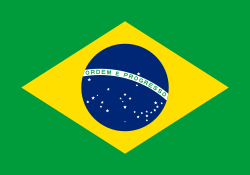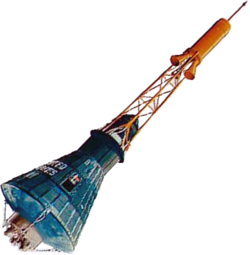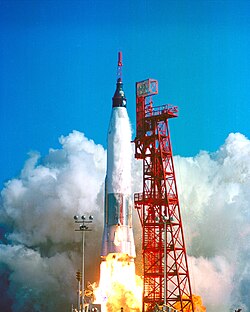Mercuryprogrammet
- För andra betydelser, se Mercury.
| Den här artikeln behöver källhänvisningar för att kunna verifieras. (2023-07) Åtgärda genom att lägga till pålitliga källor (gärna som fotnoter). Uppgifter utan källhänvisning kan ifrågasättas och tas bort utan att det behöver diskuteras på diskussionssidan. |
| Mercuryprogrammet | |
 | |
| Land | USA |
|---|---|
| Organisation | NASA |
| Syfte | Placera en amerikan i omloppsbana runt jorden |
| Status | Avslutat |
| Historik | |
| Program start | 1958 |
| Första bemannade rymdfärd | Mercury 3 5 maj 1961 |
| Sista rymdfärd | Mercury 9 15 maj 1963 |
| Plats(er) för uppskjutning | Cape Canaveral |
| Farkostinformation | |
| Farkosttyp | Kapsel |
| Bemannad(e) farkost(er) | Mercury |
| Besättningskapacitet | 1 st |
| Raket(er) | Mercury-Redstone, Atlas (raket) |


Mercuryprogrammet var ett program som styrdes av den amerikanska rymdflygsstyrelsen NASA och användes för att utröna om människor kunde vistas ute i rymden. Detta var ett av Nasas första primära mål. Den 9 april 1959 valdes sju astronauter i astronautgrupp 1 inför detta program. Mercuryprogrammet följdes senare upp av Geminiprogrammet som i sin tur ersattes av Apolloprogrammet.
Mercuryprogrammet var Nasas första bemannade rymdprogram. Det höll på från 1959 till 1963 och sammanlagt skickades 15 av totalt 20 kapslar upp i rymden varav sex var bemannade. Målet var i första hand att ta reda på om människor kunde överleva i rymden. Kapslarna var mycket små, endast 1,7 kubikmeter och det var knappt att en person fick plats i dem.
De första flygningarna gjordes som ballistiska flygningar, där kapseln återvände på grund av jordens dragningskraft. Från och med Mercury 5 flög man i omloppsbana runt jorden. En farkost som har kommit upp i omloppsbana fortsätter och kan i princip fortsätta hur länge som helst (som en satellit). För att landa igen använde man bromsraketer som tog ner hastigheten så att dragningskraften fick kapseln att återvända till jorden. Under nedfärden bromsade man ner hastigheten med fallskärmar och landningen gjordes i havet för att dämpa stöten vid landningen.
En av de sex astronauter som flugit Mercurykapseln ska ha skämtat om att kapseln var så liten att man istället för att krypa in i den, tog på sig den.
Alan Shepard blev den förste amerikanen i rymden och John Glenn blev förste amerikanen i omloppsbana runt jorden.
Rymdfärdsstatistik
| Farkost | Rymdfarare | Datum | Tid |
|---|---|---|---|
| Mercury 1 | Obemannad | 21 november 1960 | (0:00:02) |
| Mercury 1a | Obemannad | 19 december 1960 | (0:15:45) |
| Mercury 2 | Schimpansen Ham | 31 januari 1961 | (0:16:39) |
| Mercury 3 | Alan Shepard | 5 maj 1961 | 0:15:22 |
| Mercury 4 | Virgil I. Grissom | 21 juli 1961 | 0:15:37 |
| Mercury 5 | Schimpansen Enos | 29 november 1961 | (3:20:59) |
| Mercury 6 | John Glenn | 20 februari 1962 | 5:26:22 |
| Mercury 7 | M. Scott Carpenter | 24 maj 1962 | 10:22:27 |
| Mercury 8 | Walter Schirra | 3 oktober 1962 | 19:35:38 |
| Mercury 9 | L. Gordon Cooper | 15 - 16 maj 1963 | 34:19:49 |
| Totalt bemannad tid | 70:15:15 | ||
 |  |  |  |
Mercuryfärder som inte genomfördes
Mercury 10 skulle ha flugits av Alan Shepard i oktober 1963 och varit den första endygnsfärden. Efter den lyckade färden med Mercury 9 beslöt Nasa emellertid att plocka bort Mercury 10 helt från sitt program. Detta för att spara pengar i en ansträngd ekonomi där det nu byggdes Geminifarkoster och planer drogs upp inför det kommande Apolloprogrammet.
Mercury 11 skulle ha flugits av Virgil I. Grissom i slutet av 1963. Den här färden togs bort av Nasa i oktober 1962 och bara Mercury 9 och Mercury 10 skulle ha blivit ettdygnsfärder. Grissom hade vid den här tiden övergått till Geminiprogrammet.
Mercury 12 skulle ha flugits av Walter Schirra i slutet av 1963. Den här färden togs tyst bort från schemalagda flygningar i mitten på 1962.
Mercury i populärkulturen
- "The right stuff", roman av Tom Wolfe från 1979, filmatiserad 1983.
- "Hidden figures", av Margot Lee Shetterly från 2016, filmatiserad 2016.
Se även
| |||||||||||||||||||||
Media som används på denna webbplats
Författare/Upphovsman: Tkgd2007, Licens: CC BY-SA 3.0
A new incarnation of Image:Question_book-3.svg, which was uploaded by user AzaToth. This file is available on the English version of Wikipedia under the filename en:Image:Question book-new.svg
MAVEN at Mars, Artist's Concept. This artist's concept depicts NASA's Mars Atmosphere and Volatile EvolutioN (MAVEN) spacecraft near Mars. MAVEN is in development for launch in 2013 and will be the first mission devoted to understanding the Martian upper atmosphere. The mission's principal investigator is Bruce Jakosky from the Laboratory for Atmospheric and Space Physics at the University of Colorado.
The goal of MAVEN is to determine the role that loss of atmospheric gas to space played in changing the Martian climate through time. MAVEN will determine how much of the Martian atmosphere has been lost over time by measuring the current rate of escape to space and gathering enough information about the relevant processes to allow extrapolation backward in time.
NASA Goddard Space Flight Center in Greenbelt, Md. manages the project and will also build some of the instruments for the mission. In addition to the principal investigator coming from CU-LASP, the university will provide science operations, build instruments, and lead education/public outreach. Lockheed Martin of Littleton, Colo., is building the spacecraft and will perform mission operations. The University of California-Berkeley Space Sciences Laboratory is also building instruments for the mission. NASA's Jet Propulsion Laboratory, Pasadena, Calif., will provide navigation support, the Deep Space Network, and the Electra telecommunications relay hardware and operations.
For more information about MAVEN, visit www.nasa.gov/maven.The Flag of Europe is the flag and emblem of the European Union (EU) and Council of Europe (CoE). It consists of a circle of 12 golden (yellow) stars on a blue background. It was created in 1955 by the CoE and adopted by the EU, then the European Communities, in the 1980s.
The CoE and EU are distinct in membership and nature. The CoE is a 47-member international organisation dealing with human rights and rule of law, while the EU is a quasi-federal union of 27 states focused on economic integration and political cooperation. Today, the flag is mostly associated with the latter.
It was the intention of the CoE that the flag should come to represent Europe as a whole, and since its adoption the membership of the CoE covers nearly the entire continent. This is why the EU adopted the same flag. The flag has been used to represent Europe in sporting events and as a pro-democracy banner outside the Union.bendera Indonesia
Flag of Iran. The tricolor flag was introduced in 1906, but after the Islamic Revolution of 1979 the Arabic words 'Allahu akbar' ('God is great'), written in the Kufic script of the Qur'an and repeated 22 times, were added to the red and green strips where they border the white central strip and in the middle is the emblem of Iran (which is a stylized Persian alphabet of the Arabic word Allah ("God")).
The official ISIRI standard (translation at FotW) gives two slightly different methods of construction for the flag: a compass-and-straightedge construction used for File:Flag of Iran (official).svg, and a "simplified" construction sheet with rational numbers used for this file.
Flag of Israel. Shows a Magen David (“Shield of David”) between two stripes. The Shield of David is a traditional Jewish symbol. The stripes symbolize a Jewish prayer shawl (tallit).
Artists concept of Mercury capsule with launch escape system.
Alan Shepard in capsule aboard Freedom 7 before launch—1961 Alan Shepard became the first American in space on May 5, 1961. He launched aboard his Mercury-Redstone 3 rocket named Freedom 7--the suborbital flight lasted 15 minutes.
Launching of flight Mercury-Redstone 3 (MR-3), the first U.S. manned space flight, from Cape Canaveral on May 5, 1961, on a sub-orbital mission.
Astronaut John H. Glenn Jr. in his Mercury spacesuit. Image ID: S87-41328
Chimpanzee "Ham" in space suit is fitted into the couch of the Mercury-Redstone 2 capsule #5 prior to its test flight which was conducted on January 31, 1961.
Artists concept of Mercury capsule with launch escape system. Image ID: S62-04976
Launch of Friendship 7, the first American manned orbital space flight. Astronaut John Glenn aboard, the Mercury-Atlas rocket is launched from Pad 14.

































